How Send via Swap Works in Tangem Wallet
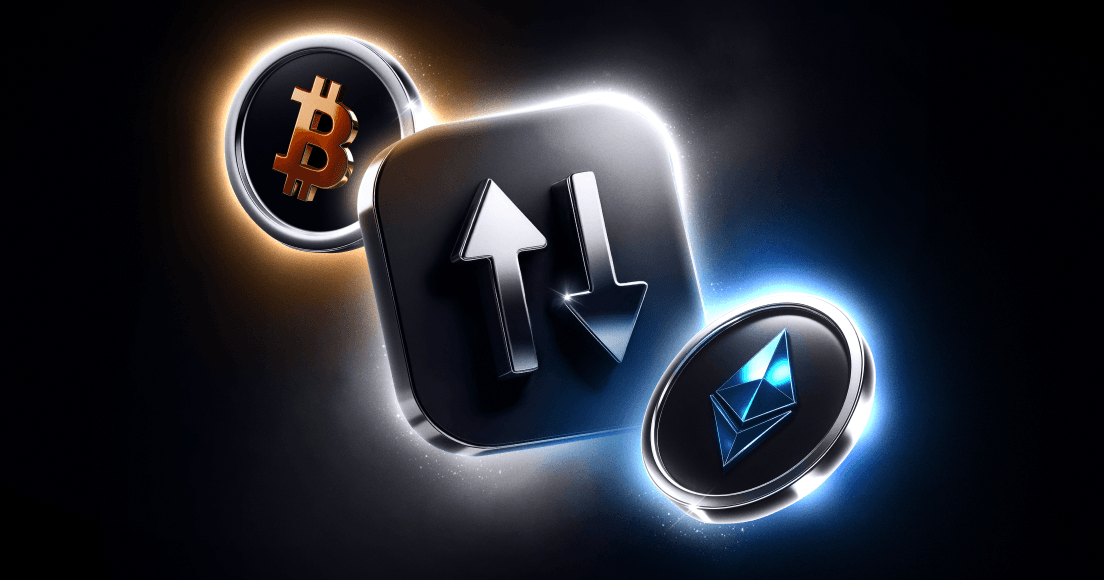
AI summary
Tangem has introduced a "Send via Swap" feature in its wallet app, allowing users to send any token they hold and have it automatically converted into the recipient’s desired token in a single, streamlined transaction. This innovation simplifies crypto transfers, reduces potential errors, and lowers fees by combining the swap and send processes, making digital asset payments more accessible for both beginners and experienced users. The feature supports a wide range of real-world use cases, including peer-to-peer payments, cross-border transfers, and business transactions, further enhancing the practicality of cryptocurrency in everyday life.
Crypto has come a long way since its early days, characterized by clunky interfaces and confusing steps that made even simple transactions challenging. Millions worldwide actively use digital assets for various purposes, including trading, investing, and payments. Despite this impressive growth, the process of sending crypto still often feels unnecessarily complicated.
Imagine this scenario: You only hold USDT (Tether), but your friend asks you to send ETH (Ethereum). You must first swap your USDT for ETH, pay the associated swap fees, and send the ETH to your friend.
This process involves two or three steps, each with its own risks, fees, and opportunities for mistakes.
This complexity can be overwhelming for crypto beginners. It's often impractical for businesses, especially those looking to streamline their operations or improve customer experience. Even seasoned crypto users frequently find these steps inconvenient, slowing transactions and adding frustration.
Recognizing these challenges, Tangem has introduced a new “Send via Swap” feature in the app. It represents a significant boost to usability, particularly for self-custody wallets.
What is Send via Swap?
At its core, Send via Swap is based on a simple yet highly effective idea. It allows users to send tokens to others while exchanging them for a different token during the process. This eliminates the need to swap first before sending tokens. Instead, you simply select the token you have and enter the token you want the recipient to receive.
Tangem manages all the complex operations behind the scenes to ensure a smooth and efficient transfer. This feature greatly simplifies token exchanges and enhances user convenience by integrating swapping into the sending process itself.
Here's an example:
- Alice only has USDT in her Tangem Wallet.
- Bob asks her to send ETH.
- With Send via Swap, Alice “Sends USDT,” selects ETH as the recipient token, and enters Bob’s ETH address.
- Alice taps Send and confirms the transaction.
The Tangem app, via integrated providers, swaps USDT → ETH and sends ETH directly to Bob, all in a seamless action. What once required two different transactions and multiple steps is now collapsed into one smooth flow.
Why this matters for everyday crypto users
On the surface, Send via Swap might look like just another convenience feature. But the implications are bigger than that. It solves some of the biggest hurdles to crypto adoption:
Ease of use for beginners
For new users, understanding how swaps and transfers work can initially feel like tackling complex advanced mathematics. To simplify this process, Tangem combines these actions into a single, streamlined operation. This integration removes the learning curve and makes sending cryptocurrency easy for everyone.
Fewer mistakes
In other wallets, swaps require navigating DEX interfaces, copying wallet addresses, and making sure you choose the right chain. Each step carries risks. By streamlining the process, Tangem reduces the chances of sending the wrong token, choosing the wrong network, or overpaying fees.
Real-world flexibility
Life doesn’t wait for you to rebalance your wallet. If your friend, colleague, or vendor wants payment in a specific token, Send via Swap ensures you can pay them instantly in the currency of their choice.
How to Send via Swap in Tangem Wallet
Tangem has always stood out in the wallet space by prioritizing security, simplicity, and real-world convenience. The Send via Swap feature continues this tradition. Here’s how to use it:
Launch the Tangem app and select the token you hold.
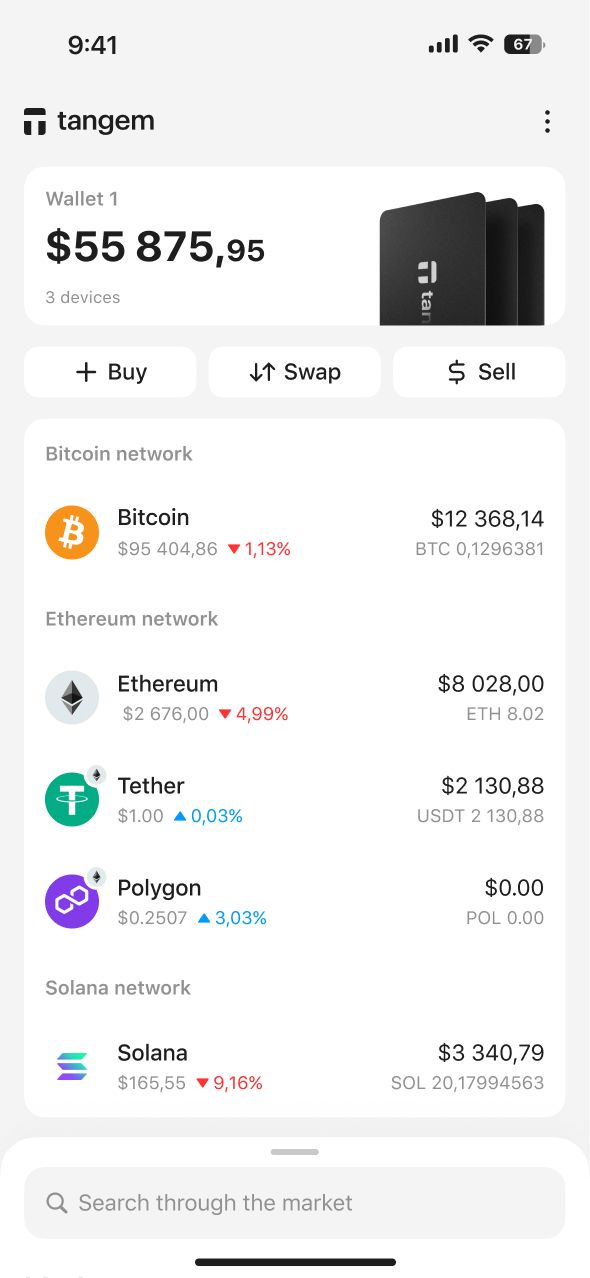
Tap Send.
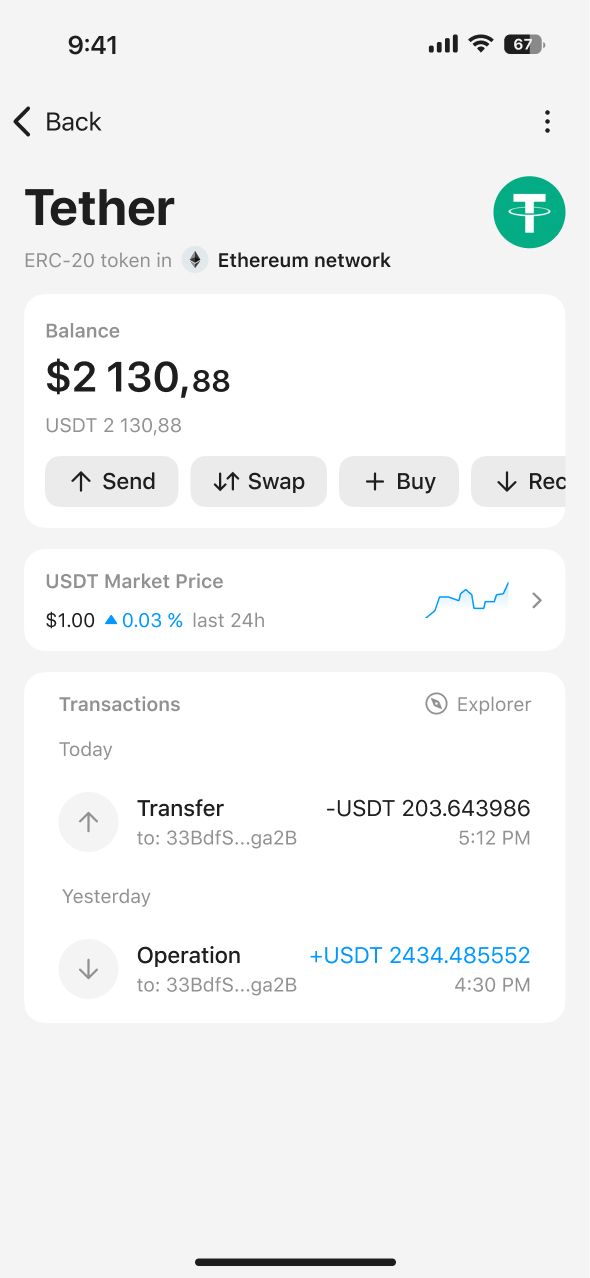
Enter the amount to send and tap Convert to another token.

Choose the token the recipient will receive.
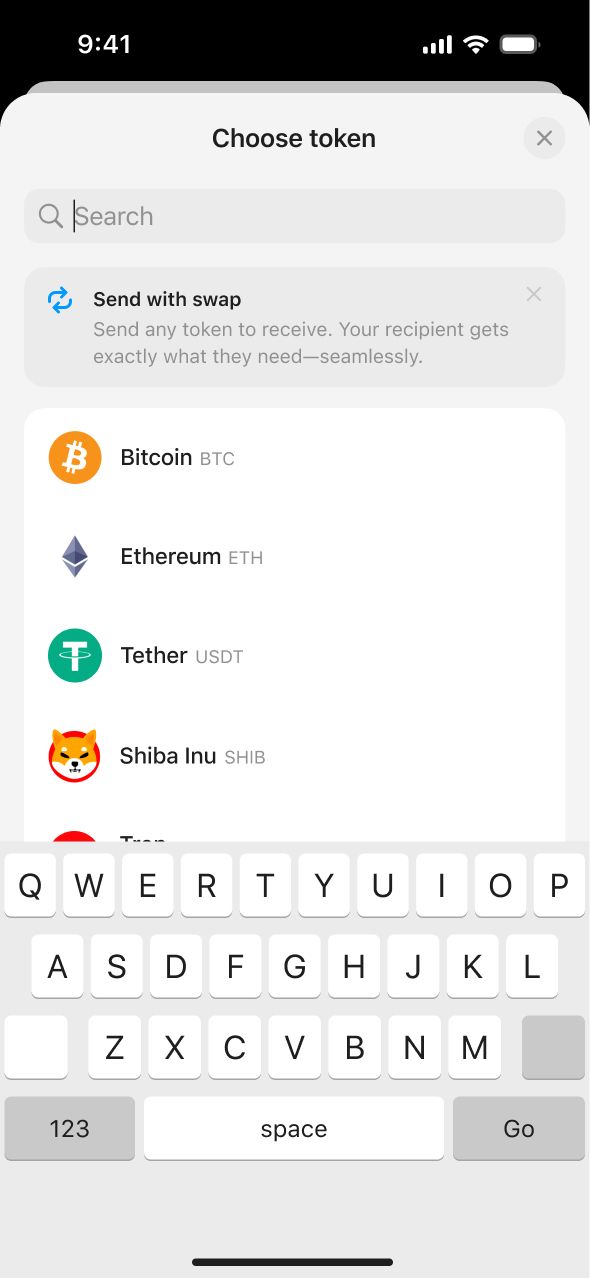
Tap Continue to confirm the exchange rate.
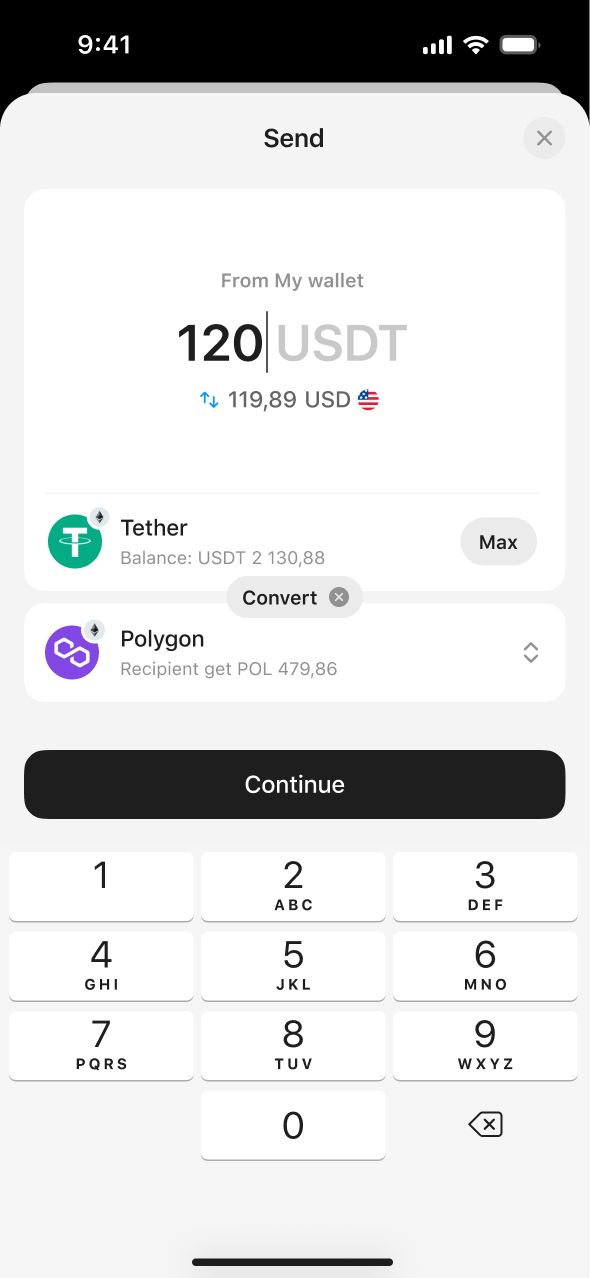
Enter the recipient’s wallet address on the receiving blockchain.
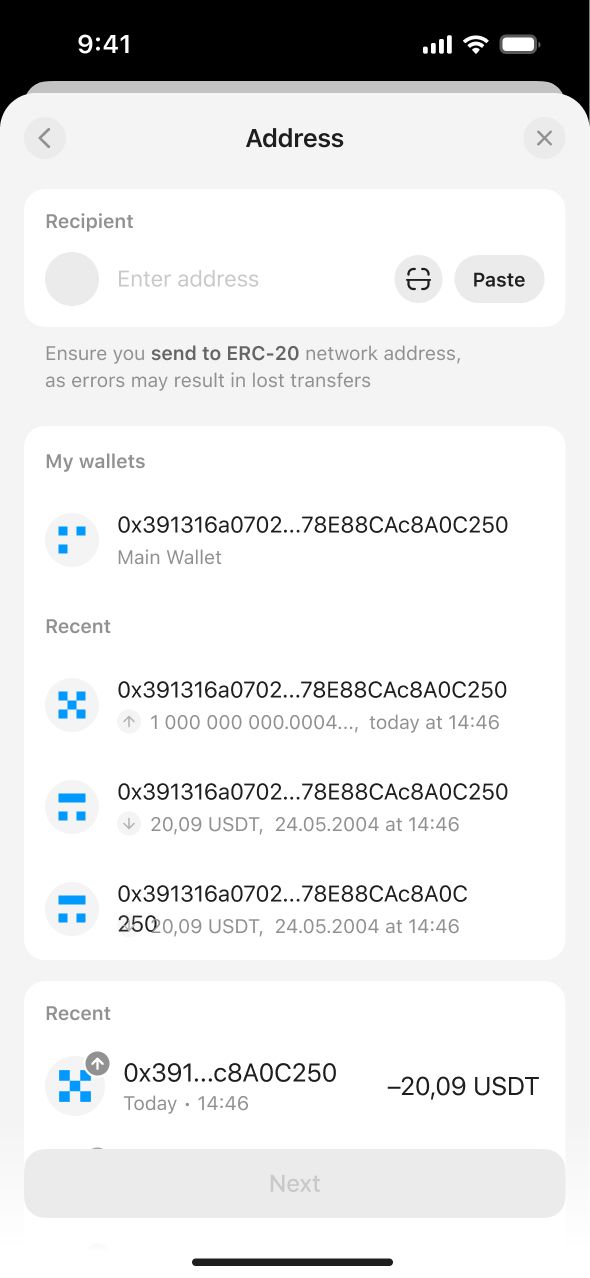
Choose the recommended swap provider if necessary and tap Send.
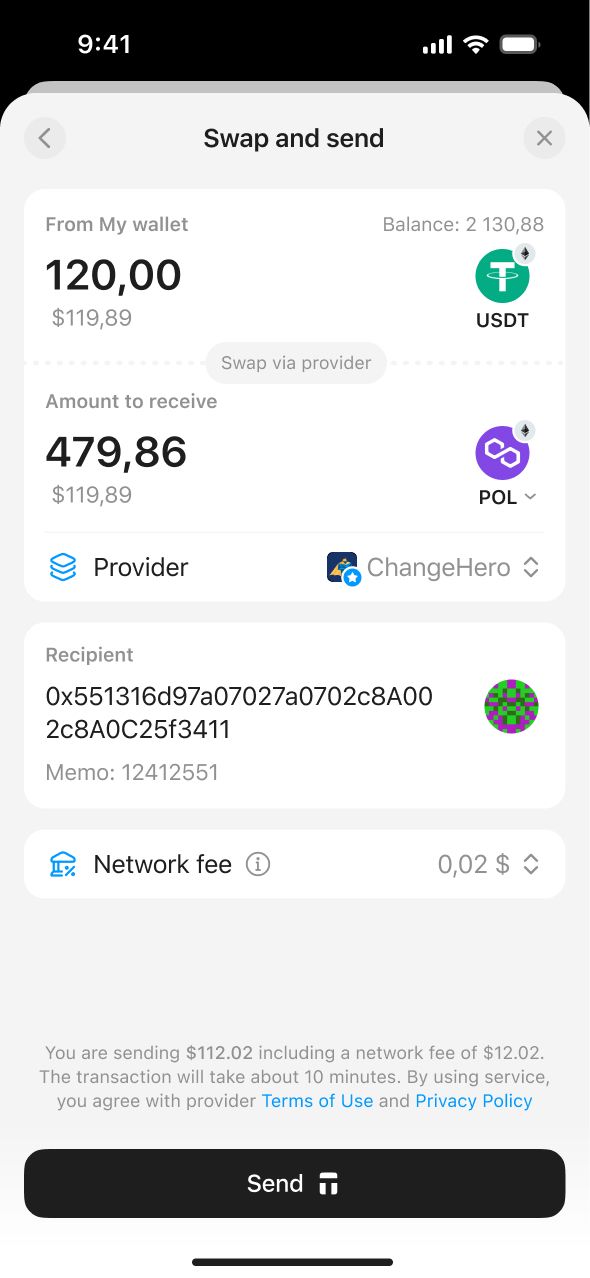
- Enter your access code or biometrics and tap your tangem wallet to sign the transaction.
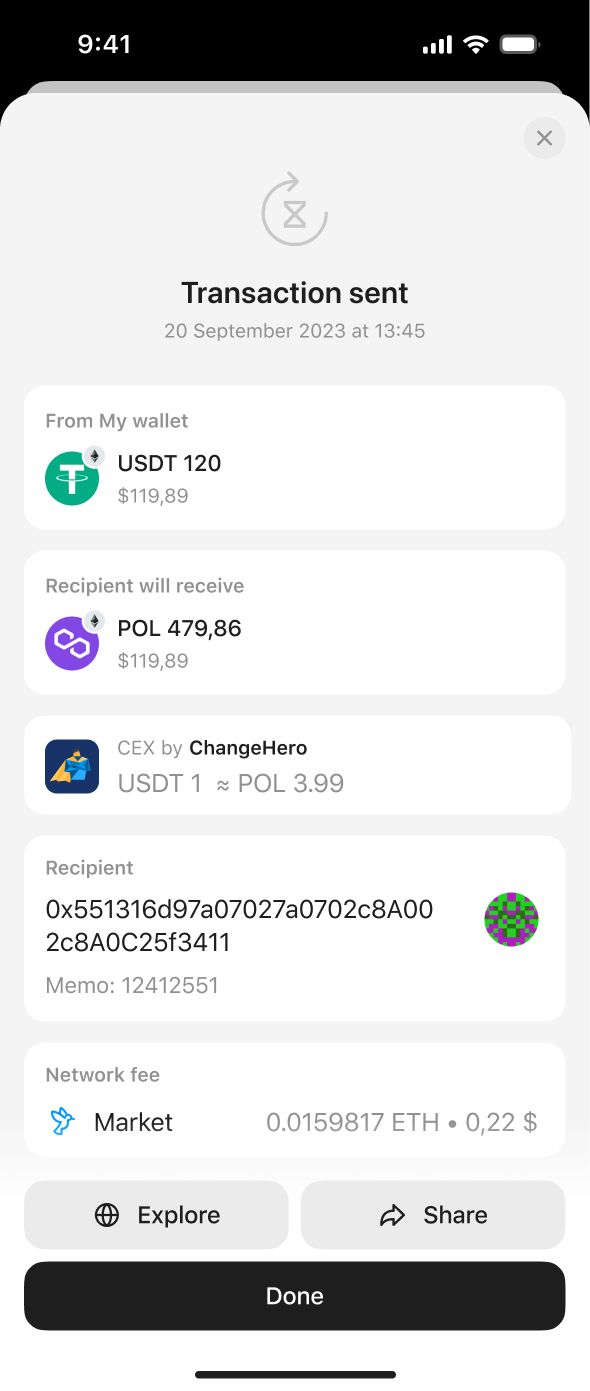
- Tap Done.
You can track your transaction in the blockchain explorer or under transaction history on the token page.
Use cases for the Send via Swap feature
The versatility of this feature enables a wide range of practical, real-world applications across various domains.
Daily peer-to-peer transfers: Friends and family can effortlessly send each other money in any token they hold. The recipient receives exactly what they want, regardless of the original token sent, making personal transactions more flexible and seamless.
Cross-border payments: Remittances represent one of the most significant opportunities in the crypto space. With features like Send via Swap, individuals can send stablecoins from abroad, while their family members back home receive the local token they prefer to use, simplifying international money transfers.
Business transactions: Companies can stabilize their treasuries by holding stablecoins or Bitcoin while still accepting payments for any token their customers use. This approach makes cryptocurrency payments much more practical and adaptable for business operations and customer transactions.
Gifting & community use: When giving someone crypto as a birthday gift, you don’t need to hold BTC, ETH, SOL, or USDT. You simply send the crypto you have, and they receive the token that best suits their needs, increasing convenience and personalization.
FAQ: Tangem’s Send via Swap feature
1. How does Send via Swap work?
You choose the asset you’re sending from, select the asset the recipient should receive, review the swap details (including fees), enter the recipient’s address, and confirm. Tangem automatically executes the swap and delivers the converted token directly to the recipient. For example, if you only hold USDT but your friend asks for ETH, you simply pick ETH as the outgoing asset. Tangem swaps your USDT into ETH and sends ETH straight to your friend, all in one transaction.
2. Which protocols and liquidity providers power this feature?
Send via Swap uses the same trusted partners and liquidity providers that already power Tangem’s existing swap functionality. This means that users don’t need to worry about new integrations or untested systems; the feature relies on the same infrastructure that already supports token swaps in the Tangem app.
3. What’s the next update for this feature?
The first version of Send via Swap focuses on making the process simple and unified, but it does have one limitation: the exact amount the recipient receives may vary slightly, depending on liquidity or minor price changes at the time of the transaction.
In October, a second version will be introduced. This update will allow you to lock in the exact amount the recipient should receive, regardless of fluctuations. For instance, the system will guarantee that outcome if you want your friend to receive the equivalent of $500 in ETH. The backend will absorb the variance, ensuring the user experience is precise and predictable.
4. Besides combining two steps into one, what are the benefits?
The obvious benefit is convenience, but Send via Swap also reduces costs and potential errors. Because swap and send are merged into one transaction, you only pay gas fees once, rather than twice. The same goes for commissions. More importantly, you don’t have to juggle multiple steps, wait for one transaction to clear before starting the next, or risk copying and pasting the wrong details along the way.
The only drawback at the first launch stage is that the recipient’s final amount may not always be an exact dollar sum, since the process depends on real-time liquidity. Still, the value received will always correspond fairly to what was sent.
5. Which tokens and chains are supported at launch?
At launch, Send via Swap supports the same tokens and pairs already available in Tangem’s swap feature. If you can swap it in the app today, you can also use it with Send via Swap. The liquidity partners are the same as those behind Tangem’s existing swap system, so the process works smoothly out of the box.
However, there is one current limitation: tokens that require a memo or destination tag, such as XRP or XLM, won’t be supported at first. That functionality will be introduced later.
6. Who needs this feature? Why did Tangem build it?
Send via Swap is designed for anyone who has ever run into the friction of needing to send an asset they didn’t already hold. It’s useful for beginners who might be intimidated by the idea of first swapping and then sending, as well as for professionals or businesses that need to simplify the way they handle payments.
Tangem built this feature because it significantly lowers the barrier to using crypto in everyday life. And within the cold wallet space, this kind of integrated swap-and-send functionality is unique. Exchanges and bridges might offer something similar, but no other hardware wallet combines it all in one place.
7. What are the risks?
There aren’t new risks introduced by Send via Swap. The risks are the same as with any token swap, such as slippage, a failed swap, or insufficient liquidity. Tangem relies on its swap partners to handle these cases, and the app communicates clearly with users if a transaction is pending or delayed. The overall risk profile is the same as what users already accept when using standard swaps.
8. Are there transaction limits?
Transaction limits depend on the liquidity providers Tangem partners with, not on Tangem itself. For larger amounts, there may be additional KYC requirements triggered by the partner. If that happens, users will be directed to complete those steps directly with the provider.
9. Is the fee structure different from a normal swap or send?
Yes, the overall cost is lower. Normally, if you swap and then send, you pay for both actions separately: one set of gas fees and commissions for the swap, and another for the send. With Send via Swap, these are merged into a single process, which means one fee instead of two. The only exception is in certain cross-chain cases, where two gas fees might still apply, but the process is more efficient overall.
10. How long does it take?
It does take slightly longer than a simple send because a swap has to occur first. However, it is still quicker than performing a swap and a send separately. The extra time is usually negligible for most assets. The only exceptions are slower networks, like Bitcoin, where confirmations naturally take longer.
In the Tangem app, users see clear status updates during the process, such as “awaiting confirmation,” “swap completed,” or “assets sent.” Push notifications keep you informed as soon as the transaction is finalized.
